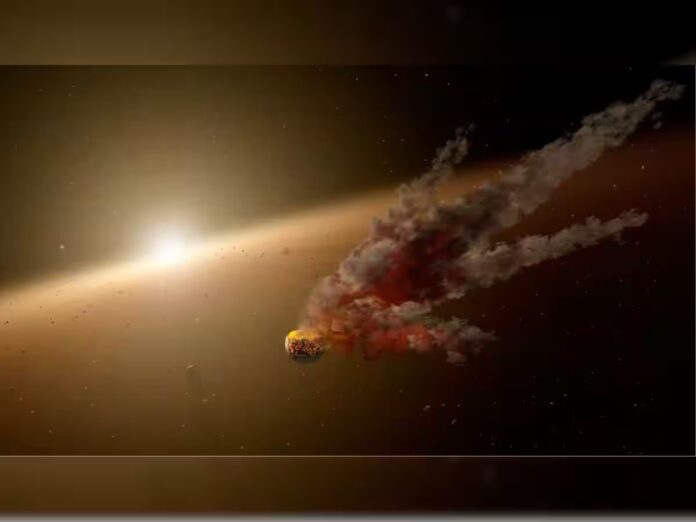In a jaw-dropping celestial event, Asteroid 2020 XR, a massive space rock spanning approximately 1,200 feet in diameter, made a close approach to Earth at 12:27 am ET on December 4 (10:57 am IST). The asteroid, comparable in size to a football stadium, passed within 2.2 million kilometers of our planet at a staggering speed of 44,300 kilometers per hour. This marked the asteroid’s closest approach to Earth in recorded history.
The European Space Agency (ESA) described the asteroid as a “potentially hazardous” Near-Earth Object (NEO), a term used for celestial objects that come within 7.5 million kilometers of Earth and are larger than 500 feet in diameter. Despite its alarming size and proximity, astronomers assured that it posed no threat to Earth, as its trajectory was thoroughly calculated and monitored.
A Rare Glimpse Of A Giant Space Rock
For space enthusiasts, the Virtual Telescope Project (VTP) provided an opportunity to catch a live glimpse of Asteroid 2020 XR as it flew past Earth. The ESA, in collaboration with various observatories, streamed the event for the public, allowing millions to witness the asteroid’s historic flyby in real-time.
Astronomers emphasized that while the asteroid was far enough to avoid any direct impact, its sheer size and speed could devastate a small city if it were to collide with Earth. Measuring roughly 1,200 feet in diameter, Asteroid 2020 XR is classified as one of the larger NEOs that regularly come under close scrutiny by space agencies such as NASA and ESA.

A Visitor From 1977: The Asteroid’s Past Encounters
Interestingly, this isn’t Asteroid 2020 XR’s first visit to our cosmic neighborhood. According to NASA’s Jet Propulsion Laboratory (JPL), its last close approach was in 1977, long before its discovery. At that time, it passed a safe distance of 16 million kilometers from Earth.
The asteroid was officially discovered years later, and scientists initially believed it could impact Earth in 2028, sparking widespread concern. However, further calculations by ESA’s Near-Earth Object Coordination Center clarified that its trajectory would take it even farther away—18.2 million kilometers—during its 2028 flyby.
Future Projections: Asteroid 2020 XR’s Next Visit In 2196
Asteroid 2020 XR’s interactions with Earth aren’t over yet. According to projections, the asteroid will make an exceptionally close approach once again in the year 2196, approximately 172 years from now. While its exact trajectory is yet to be analyzed in detail, early observations suggest it will not pose any imminent danger to the planet.
The event serves as a reminder of the importance of monitoring such celestial objects, as even minor changes in their orbits could have catastrophic consequences. With advanced tracking systems and predictive modeling, agencies like NASA and ESA continue to ensure Earth’s safety from potential asteroid impacts.

A Close Call With Another Asteroid Over Siberia
Adding to the excitement of the week, another asteroid entered Earth’s atmosphere on December 3, just hours before Asteroid 2020 XR’s approach. This smaller space rock, initially designated as C0WEPC5 and later renamed 2024 XA1, made its way into the planet’s atmosphere over Siberia.
Unlike the colossal Asteroid 2020 XR, this space rock measured only 1.6 to 4 feet in size, comparable to a small bicycle tire. It was Earth’s fourth imminent impactor of 2024, demonstrating how frequently smaller asteroids interact with our planet. Fortunately, such small objects typically disintegrate upon entering the atmosphere, posing little to no threat to life or property.
NASA’s Vigilance: Tracking Potentially Hazardous Objects
Asteroid 2020 XR’s close encounter highlights the critical work of space agencies in monitoring NEOs. NASA’s asteroid tracking system keeps a close eye on objects that may come within 7.5 million kilometers of Earth. Any object larger than 500 feet in diameter is classified as “potentially hazardous,” as such asteroids could cause widespread devastation if they were to collide with Earth.
The agency uses advanced telescopes and radar systems to identify, track, and predict the trajectories of these objects. While Asteroid 2020 XR did not pose any immediate threat, its size and proximity underscored the need for vigilance and preparedness.
A Global Effort To Prevent Future Impacts
Space agencies across the globe are working collaboratively to develop strategies for planetary defense. Projects like NASA’s DART (Double Asteroid Redirection Test) and ESA’s Hera mission aim to study asteroid deflection techniques, which could one day be used to avert a collision.
Such initiatives are vital, as even small asteroids like 2024 XA1 can cause localized damage, while larger ones like 2020 XR have the potential to trigger catastrophic events. With continued advancements in technology, scientists are optimistic about mitigating future asteroid threats.

A Reminder Of Earth’s Vulnerability
Asteroid 2020 XR’s flyby, along with the Siberian asteroid event, serves as a stark reminder of Earth’s vulnerability to cosmic objects. While modern technology has significantly improved our ability to detect and track asteroids, the unpredictability of space demands constant vigilance.
For now, humanity can breathe a sigh of relief, knowing that Asteroid 2020 XR’s closest approach is behind us. As we look to the skies, the event offers an opportunity to marvel at the wonders of the universe while recognizing the importance of safeguarding our planet.

